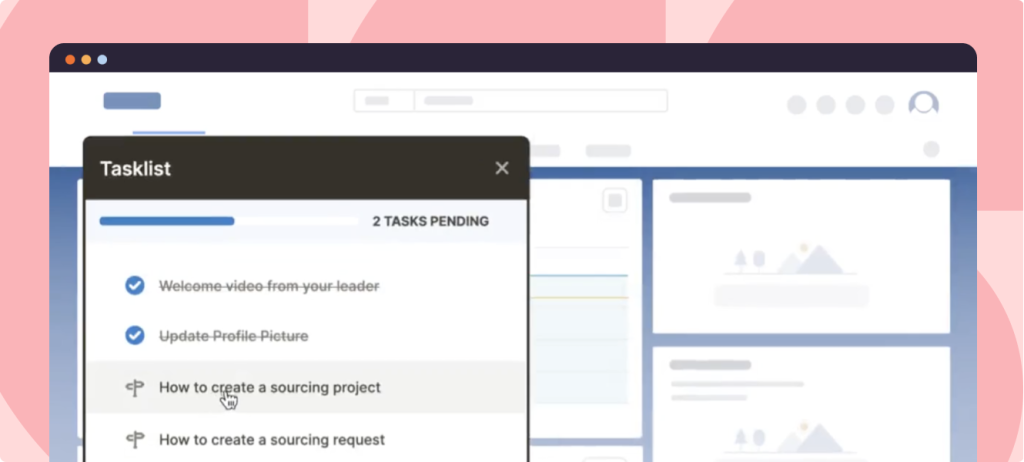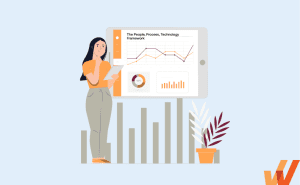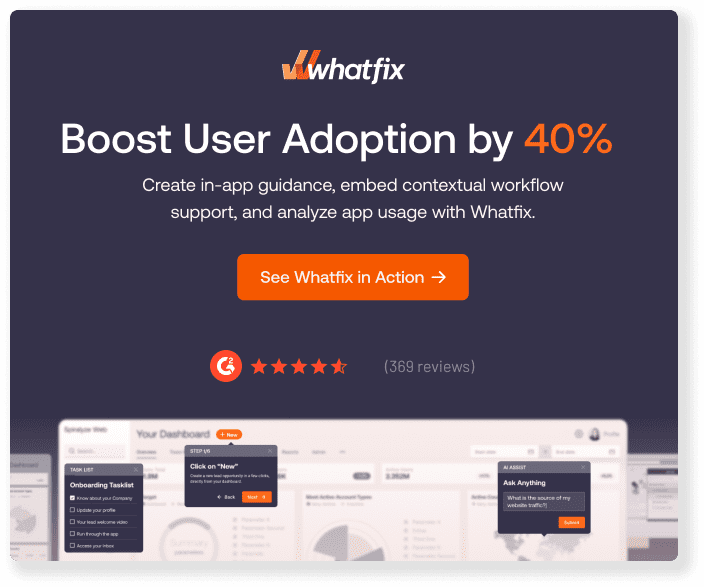Change is an inevitable part of an organization’s growth and adaptation. Whether implementing new technologies, restructuring processes, changing leadership, or refocusing on new strategies, change management is critical in driving successful transitions.
Change is an inevitable part of an organization’s growth and adaptation. However, research indicates that nearly 70% of change initiatives fail due to poor implementation, insufficient training, and lack of ongoing support. Recognizing this underscores the importance of effective change management. To enhance the probability of success, organizations must not only adopt cutting-edge software tools and technologies but also leverage comprehensive frameworks, change models, change exercises, and employee training across the entire change lifecycle.
This article breaks down change management into six crucial phases: assessment, planning, implementation, communication, training/adoption, and enterprise-wide change.
We will explore a curated list of the best change management tools, both software and non-software, tailored to support leaders in executing successful change initiatives. Each tool will be examined for its standout features, benefits, and distinctive qualities to empower change leaders in making informed decisions for their next project.
What Are Change Management Tools?
Change management tools are resources, methodologies, models, or software that help organizations navigate transitions effectively and minimize disruptions. These tools are not one-size-fits-all solutions; they address specific aspects of the change process, from planning to implementation.
Change management tools offer various functionalities that aid change communication, collaboration, project management, documentation, end-user training, and knowledge sharing. They serve as a centralized platform for change management activities and enhance the effectiveness of change initiatives.
Types of Change Management Tools
We’ve broken down the best change management tools into different categories based on the challenges they help overcome and the change milestone or lifecycle event they help facilitate. We have segmented change tools into the following categories:
- Change Management Tools for Assessment: Help identify the scope, readiness, and potential impact of change within an organization.
- Change Management Tools for Planning: Provide frameworks and methodologies to design structured, actionable change strategies and roadmaps.
- Change Management Tools for Implementation: Support the execution of change initiatives by managing tasks, tracking progress, and ensuring alignment with objectives.
- Change Management Tools for Communication: Facilitate clear, consistent messaging to stakeholders through multi-channel communication platforms.
- Change Management Tools for Training and Adoption: Equip employees with the necessary skills and knowledge to embrace change and ensure smooth integration.
Best Tools for Change Management Assessment
How do you prepare and assess backlogged change projects or tech debt that you know needs to be transformed? This section explores the best tools specifically designed to assess change management projects. These tools empower leaders to not only identify the scope of change initiatives but also evaluate their team’s readiness to embrace new directions:
Prosci Enterprise Change Management
Prosci Enterprise Change Management is a holistic framework for embedding change management capabilities into an organization’s culture. It includes tools, methodologies, and training programs to equip leaders and employees with the skills needed to manage change at scale. This approach ensures that change management becomes a core competency across the organization.
ADKAR Model
The ADKAR Model is a foundational change management model for assessing individual readiness for change. It breaks the change process into five critical stages: Awareness, Desire, Knowledge, Ability, and Reinforcement.
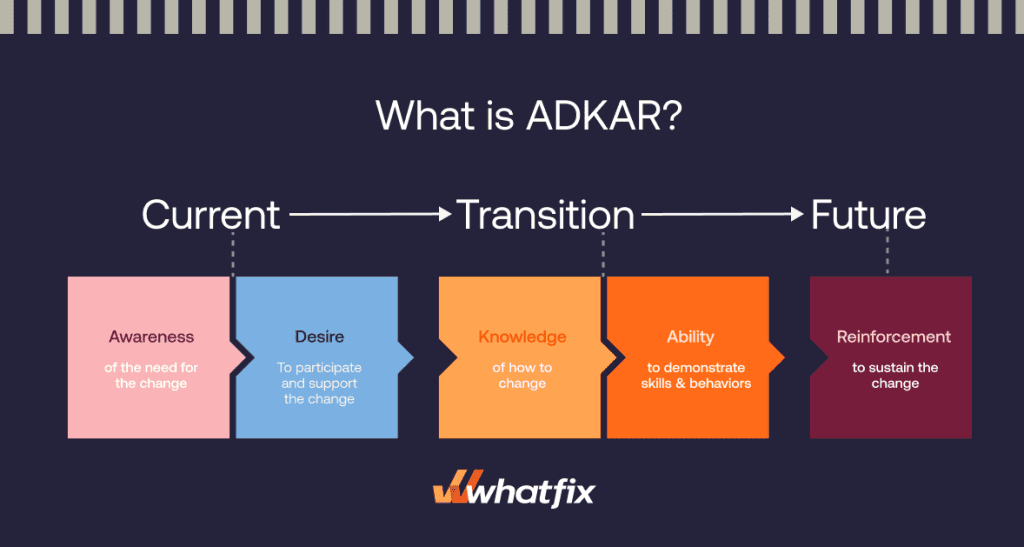
By examining these stages, organizations can identify where employees are struggling, whether it’s understanding the need for change, lacking the desire to participate, or needing skills to adapt. ADKAR enables leaders to pinpoint specific areas of resistance and take targeted actions, ensuring smoother transitions at the individual level.
McKinsey 7-S Framework
The McKinsey 7-S Framework is a powerful model for organizational assessment that examines seven interconnected elements—Strategy, Structure, Systems, Shared Values, Skills, Style, and Staff—to evaluate how well they align with the proposed change.
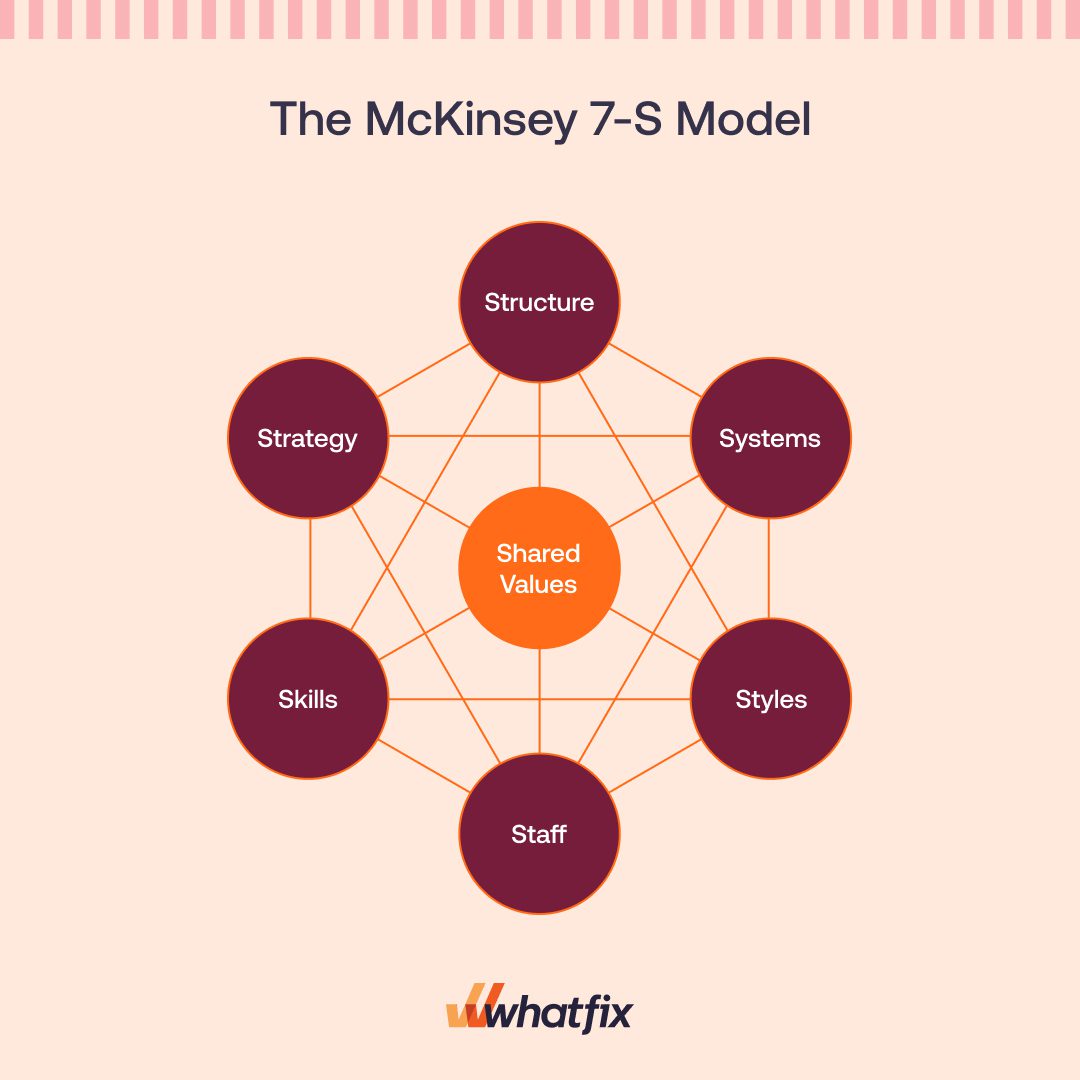
Misalignments in these elements often act as roadblocks to successful implementation. By using the 7-S Framework, organizations can create a cohesive approach, ensuring that all parts of the business are synchronized with the change initiative.
RiskWatch
RiskWatch is a change management software tool designed to identify and mitigate risks associated with change management initiatives. It uses risk assessment methodologies to analyze potential vulnerabilities, calculate risk levels, and provide actionable insights. RiskWatch is particularly valuable for complex projects with high stakes, such as regulatory compliance or IT system migrations. By proactively managing risks, organizations can minimize disruptions and improve the likelihood of success.
Aris by Software AG
Aris focuses on business process analysis and simulation. It enables organizations to map their current processes, visualize the impact of proposed changes, and simulate outcomes to predict potential challenges. This tool is ideal for organizations undertaking large-scale operational transformations, as it ensures that new processes align with strategic goals and organizational capabilities.
The Change Shop
The Change Shop tool provides a platform to assess organizational readiness and track progress throughout the change process. It uses real-time analytics to measure employee engagement, identify resistance patterns, and benchmark results against industry standards. By offering a data-driven approach, the Change Shop helps organizations maintain momentum and ensure accountability during change initiatives.
OrgMapper Influence
OrgMapper Influence is a unique tool designed to identify key influencers within an organization. These influencers can play a crucial role in driving change by acting as champions who advocate for the initiative and motivate others to get on board. OrgMapper Influence allows organizations to leverage social dynamics effectively, ensuring greater buy-in and smoother adoption of change initiatives.
Change Management Tools for Planning
When it comes to navigating the turbulent waters of organizational change, effective planning is your lifeboat. The right change management planning tools can make all the difference, transforming an overwhelming endeavor into a structured and actionable roadmap.
From comprehensive frameworks that align your vision to actionable methodologies that break down complex tasks into manageable milestones to software planning apps, these tools are designed to give you clarity and confidence.
Kotter’s 8-Step Model
Kotter’s 8-Step Model is one of the most widely recognized frameworks for planning change. It emphasizes the importance of building a strong foundation for change through steps like creating a sense of urgency, building a guiding coalition, and forming a strategic vision.

The model also highlights the significance of generating short-term wins and sustaining momentum to achieve long-term goals. By following Kotter’s structured process, organizations can ensure that every stage of planning is deliberate and impactful.
Lewin’s Change Model
Lewin’s Change Model provides a simple yet effective approach to planning change through its three stages: Unfreeze, Change, and Refreeze.

The model focuses on preparing the organization for change (Unfreeze), implementing the change (Change), and reinforcing new behaviors or processes to make them permanent (Refreeze). This approach is particularly useful for organizations seeking to address cultural or structural challenges.
Fluid
Fluid is a change management planning tool that focuses on adaptability and collaboration. It provides organizations with a platform to create detailed project plans, track progress, and adjust strategies in real-time. Fluid is especially effective for dynamic environments where flexibility and iterative planning are critical.
Project Management Apps
Project Management Apps, such as Jira, Trello, and Asana, are invaluable tools for managing change initiatives. They help organizations plan and prioritize tasks, assign responsibilities, and monitor progress. These apps also enable teams to collaborate effectively, ensuring alignment across departments and stakeholders. By integrating project management tools into the planning phase, organizations can maintain focus and streamline execution.
Proxima
Proxima is a robust change management tool that combines planning and analytics. It provides organizations with data-driven insights to plan change initiatives and measure their effectiveness. Proxima is particularly useful for organizations that rely on predictive analytics to guide decision-making.
ChangeGear
ChangeGear is an IT-focused change management tool that assists in planning and implementing IT changes. It provides a structured framework for tracking change requests, assessing risks, and ensuring compliance with organizational policies. ChangeGear is ideal for organizations undergoing digital transformation or IT system upgrades.
Change Management Tools for Implementation
Implementing change within an organization can be complex, but the right tools can facilitate a smoother process. Here are some effective change management tools that can support implementation:
ITSM tools
IT Service Management (ITSM) tools, such as BMC Helix ITSM and ServiceNow, play a critical role in implementing changes, especially in IT environments. These tools provide robust workflows to manage change requests, monitor progress, and ensure compliance with industry standards. They streamline the execution of IT-related changes by offering features such as incident tracking, asset management, and automated approvals. By integrating ITSM tools into implementation processes, organizations can minimize disruptions, enhance transparency, and maintain consistency.
Star Team by MicroFocus
Star Team by MicroFocus is a change and configuration management tool specifically designed for development environments. It supports the implementation of software changes by offering centralized control over configurations, tracking change requests, and enabling real-time collaboration among development teams. This ensures that software updates and version controls are executed seamlessly, reducing the risk of errors and delays.
Freshservice
Freshservice is a cloud-based IT service management solution that simplifies change implementation through automated workflows, robust documentation, and built-in risk assessment tools. It allows organizations to track change requests, align them with business goals, and ensure timely execution. Freshservice is particularly beneficial for organizations transitioning to new IT systems or upgrading existing infrastructure.
Cherwell Service Management
Cherwell Service Management provides enterprise-wide solutions for managing IT and business changes. Its flexible workflows and automation capabilities enable organizations to adapt to new challenges quickly. Cherwell is particularly effective for companies undergoing digital transformation or restructuring efforts, ensuring that changes are implemented efficiently and with minimal disruption.
Kaizen Methodology
The Kaizen Methodology emphasizes continuous improvement and is vital to implementing incremental changes. It focuses on engaging employees at all levels, encouraging small, ongoing adjustments rather than sweeping transformations. Kaizen’s collaborative nature ensures that changes are well-received and integrated smoothly into existing processes, making it highly effective for operational improvements.
Change Management Tools for Communication
Effective communication is crucial in change management to ensure that all stakeholders are informed, engaged, and aligned with the changes being implemented. Here are some key tools that can facilitate communication throughout the change process:
RACI Matrix
The RACI Matrix is a widely used tool that clarifies roles and responsibilities during change initiatives. By designating individuals as Responsible, Accountable, Consulted, or Informed, organizations can ensure clear communication and avoid confusion on change roles and who needs to do what. The RACI Matrix fosters accountability and keeps stakeholders aligned throughout the process.
Team Communication Apps
Team communication apps such as Slack, Microsoft Teams, and Zoom are indispensable for maintaining clear and consistent communication during change implementation. These apps facilitate real-time discussions, file sharing, and collaboration across geographically dispersed teams. By enabling seamless communication, these tools ensure that everyone stays informed and engaged.
Stakeholder Mapping
Stakeholder Mapping is another essential communication tool that helps organizations identify and categorize stakeholders based on their influence and interest in the change initiative. This process enables tailored communication strategies to address stakeholder concerns effectively and build stronger support for the change.
Howspace
Howspace is a digital collaboration platform that focuses on engagement and communication during organizational change. It combines AI-driven insights with interactive tools to facilitate workshops, gather feedback, and ensure that all voices are heard. By fostering active participation, Howspace helps create a sense of ownership and buy-in among stakeholders.
Change Management Tools for Training and Adoption
The right change management tools can bridge the gap between strategy and execution. Whether you’re introducing new technology, shifting company culture, or revamping workflows, these tools help guide employees through change with hands-on training and support, making adoption stick.
Change Curve Model (Kubler-Ross)
The Kubler-Ross model provides insights into the emotional journey of individuals during change. It helps organizations understand and anticipate employee reactions, from denial to acceptance. By aligning training efforts with these stages, leaders can offer the right support at the right time, ensuring smoother adoption.
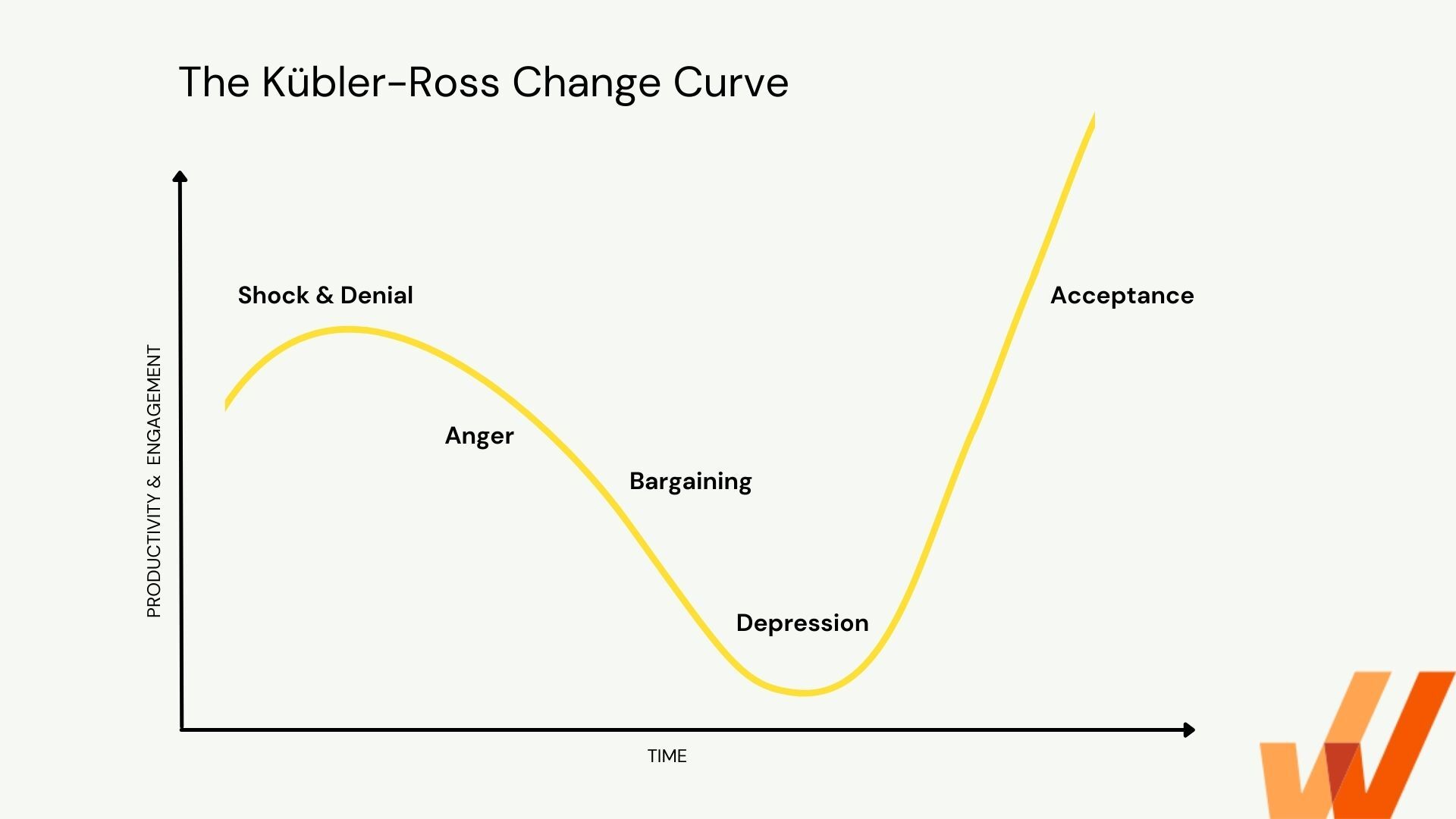
Application Sandboxes
Application sandboxes are virtual environments where employees can practice using new tools or systems before full implementation. These sandbox environments provide a risk-free setting for training, allowing employees to experiment and gain confidence without affecting live operations. This is especially useful for complex software rollouts or system upgrades.
With Whatfix Mirror, IT teams, and application owners can quickly create replica sandbox environments of web applications and enterprise software without technical dependencies. Create in-app guided experiences like Tours, Flows, Smart Tips, and Task Lists to guide new users through the simulated application and provide hands-on user training without risking live application usage.

Digital Adoption Platform
Digital Adoption Platforms (DAPs), such as Whatfix DAP, are designed to enhance user adoption of new technologies. They support end-users (employees and customers) in the flow of work with in-app guidance, on-screen tutorials, self-help support, and performance analytics to help users navigate new systems effectively. DAPs reduce resistance to change by offering real-time support and ensuring a smoother learning curve.
LMS
Learning Management Platforms such as SAP Litmos, TalentLMS, Moodel, etc., provide a framework that handles all aspects of your employee training – from housing, delivering, organizing, tracking, and measuring the effectiveness of training content. They enable organizations to deliver training programs that ensure employees are well-prepared to adopt new processes or systems.
Benefits of Change Management Tools
Here are some of the most significant benefits of change management tools
- Accelerated change adoption: Change management tools streamline the transition process by providing structured methodologies and real-time guidance. Tools like Digital Adoption Platforms (e.g., Whatfix, WalkMe) deliver in-app assistance, helping users quickly adapt to new systems or processes, thereby reducing resistance and accelerating adoption.
- Improved communication and collaboration: Tools like Slack and MS Teams enhance transparency and foster team collaboration. These tools ensure that all stakeholders are informed, their concerns addressed, and their roles clarified, leading to a more unified approach to change initiatives.
- Enhanced project planning and tracking: Project management apps like Jira and Trello enable organizations to create detailed change plans, assign tasks, set deadlines, and monitor progress. This ensures better alignment with objectives, minimizes delays, and provides visibility into every stage of the change process.
- Efficient documentation and knowledge sharing: Change management tools ensure seamless documentation of processes, policies, and lessons learned. Platforms like ServiceNow and Confluence centralize knowledge repositories, making it easier to track changes and provide access to critical information across the organization.
- Contextual training and user support: Tools such as corporate LMS and Digital Adoption Platforms offer tailored training and real-time support. By providing step-by-step guides and hands-on training, these tools help employees gain the skills needed to adopt changes with confidence.
- Real-time feedback: Change management tools like Howspace and The Change Shop facilitate real-time change feedback collection from employees and stakeholders. This enables organizations to address concerns promptly, adapt strategies as needed, and maintain momentum throughout the change control process.
When Should You Use a Change Management Tool?
Here are some scenarios where using a change management tool is highly beneficial.
1. Implementing a new enterprise software
When introducing new systems or software across an organization, a change management tool assists in managing training programs, documenting new processes and procedures, and providing a platform for user support and troubleshooting.
2. Updating a complex process, task, or workflow
When introducing or updating a complex process or workflow, change management tools help managers assign tasks, track progress, facilitate communication, and enable automated alerts to keep everyone up to date and on the same page.
3. Accelerate rollout and adoption of a new project
A change management tool accelerates the rollout and adoption of a new project by providing
- effective communication and collaboration to ensure that project information and updates are easily accessible to all stakeholders.
- efficient project planning and tracking that allows teams to set clear goals, assign tasks, and monitor progress in real time.
- stakeholder engagement through platforms for feedback gathering, addressing concerns, and fostering a sense of ownership.
Overall, a change management tool optimizes project management processes, enhances communication, and empowers stakeholders, resulting in an accelerated rollout and increased adoption of the new project.
4. Change in organizational leadership or structure
A change management tool enables a change in organizational leadership or structure by providing channels to share the rationale behind the change, address concerns, and gather feedback from employees. This helps build understanding and support for the new leadership or structure. Furthermore, these tools incorporate monitoring capabilities to successfully navigate and implement changes in organizational leadership or structure.
How to Choose a Change Management Tool
If you’ve narrowed your search for a change management tool to a handful of good options, how do you decide on one? There are some key factors to consider that will help you find the right tool for your organization and situation. Here is how to choose a change management tool.
- Customization: Customization options should be a top priority when choosing a change management tool. Effective change management tools can be customized to closely match your organization’s processes, workflows, and branding to make change management seamless.
- Scalability: Scalability is an important aspect of change management tools because you want to invest in a tool that can grow with your business. Change management tools need to be able to adapt as your organization grows and processes become more complex.
- Security: Security should also be a top priority when choosing a change management tool, as this tool will have access to your organization’s data. In addition to protecting sensitive data, ensure the tool you choose is compliant with any regulations your industry may have.
- Customer support: Investigate the levels of support offered with any change management tool you’re considering. Look for reviews from real customers to see how a potential tool provider responds when support is needed to ensure you don’t get stuck with a tool you can’t use when issues inevitably arise. Support is especially important if you need a highly customized solution.
- Integration: Consider how well a change management tool will integrate with the rest of your tech stack. Change management is difficult, but you can make transitions smoother for your users by finding a tool that integrates with the existing tools they’re familiar with and guides them through new processes within the applications themselves.
Change Clicks Better With Whatfix
Successful change management isn’t just about introducing new business processes or implementing new technology—it’s about ensuring employees adopt them effectively. Whatfix empowers organizations to execute seamless change projects by supporting users at every stage of the transition.
- Whatfix Mirror accelerates end-user onboarding with hands-on training in a sandbox environment, allowing employees to learn by doing before they work in the live system. You can also conduct user acceptance testing (UAT) and beta testing, gathering real-time feedback to uncover issues, optimize processes, and ensure a smooth go-live – all in your sandbox user testing and training environment, without requiring technical resources.
- Whatfix DAP provides in-app guidance to help users master core tasks, complex workflows, and infrequent processes without disrupting their productivity. Self Help integrates your knowledge base and support documentation directly into your enterprise applications, offering just-in-time assistance and support in the flow of work. With in-app surveys, you can continuously collect user feedback to refine and enhance the experience.
- Whatfix Product Analytics gives you deep insights into how employees complete tasks, where they struggle, and whether they’re adopting new workflows correctly. By identifying friction points—such as incorrect steps or errors in data entry—you can implement a data-driven improvement plan, reinforcing success with updated guidance and training.
With Whatfix, change isn’t disruptive—it’s intuitive. Equip your workforce with the right tools to adapt seamlessly, reduce resistance, and drive lasting digital transformation. Learn how Whatfix can power your change management strategy and request a demo today!
